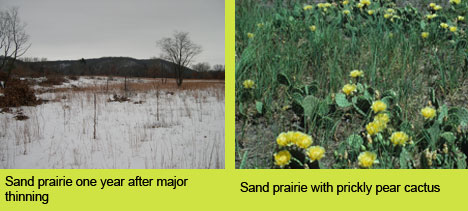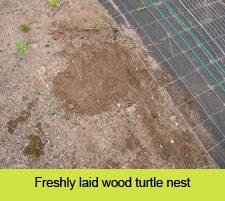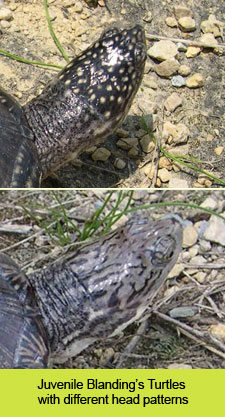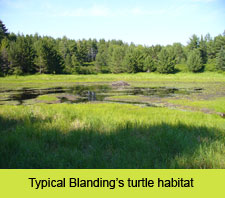2024 | 2023 | 2022 | 2021 | 2020 |
2014 Highlights
Ornate Box Turtle Program Accomplishments

Oak barrens and prairie management was conducted on a State Natural Area by Turtles For Tomorrow volunteers again in 2014. This work included pulling or treating noxious invasive plants like Spotted knapweed and Honeysuckle, removing clones of aspen that threaten to shade out open canopy habitats and the thinning of Black Oak trees and brush to restore a healthy matrix of microhabitats that are important to Ornate Box Turtles, but also for other reptiles and a broad array of grassland and savanna bird species. A total of 285 hours were donated in 2014. The management once again included a work party involving students and teachers from the Prairie du Sac High School. Since 2012, over 700 hours have been donated to manage this unique State Natural Area. The management work is continuing in 2015 with a goal of restoring a large wooded island within the prairie to oak barrens which will support scattered Oak trees and brush. Funds are needed to cover expenses, such as gas, for driving to the site (1,790 miles for work in 2014), and to cover equipment costs (gas and oil) and equipment maintenance (brush cutter blade and chain saw chain replacements and other miscellaneous parts) (Total annual need- $1,200).
Wood Turtle Program Highlights

The program continued its focus on creating and restoring communal nesting sites for Wood Turtles in 2014. Three nesting sites were finished on National Forest Service lands in northeastern Wisconsin. Of these sites, two were new sites and one was a restored site. In addition, one additional site was created on a corporate property on the Menominee River in NE WI. An additional three nest sites were completed in northwestern Wisconsin on private and Wisconsin Department of Natural Resources lands. These seven sites were completed prior to the 2014 nesting season. All of the sites were equipped with predator exclusion fences. A new and smaller nesting site design was used in 2014 and is likely to become the new standard for future sites. These sites are less costly to construct and require less effort to manage and maintain. Wood Turtles nested on six of these seven sites in their first season! Of these six sites only one experienced nest predation and we hope to remedy that problem in 2015. An additional two sites were partially installed late in 2014 and are scheduled for completion prior to the 2015 nesting season. At least two other nest site locations were identified in 2014 for future installation.

To date (2011-2014), one natural nest site has been fenced, four nest sites have been restored and nine have been created. Of these 14 sites, nine have predator exclusion fences. Twelve of these nest sites are used by turtles.
Plans are underway for 2015 to work with the National Forest Service in two new districts in northwestern WI along with the Lac Courte Oreilles Tribe. We hope to raise $5,100 to create three nesting sites.
Blanding’s Turtles Telemetry Program Accomplishments

Turtles For Tomorrow and UW-Whitewater initiated a long-term telemetry study with headstarted Blanding’s turtles in 2013 to determine their long-term survival rates. Long-term telemetry programs are exceedingly rare with turtles, and the results of this work will hopefully provide very useful data on the actual value of headstarting as a conservation strategy. This project will also compare habitat selection and home ranges (size of areas the turtles use) with research on naturally produced juvenile Blanding’s turtles. In 2013, 19 juvenile turtles that had been headstarted for about one year post hatch were fitted with transmitters and released at the site where their adult mothers had originated. After release, turtles were relocated once per week using radio telemetry equipment. The geographic location, habitat characteristics and behaviors associated with each turtle was recorded during each relocation.

During the first year the survival rate was 73.7%. In Year 2, 2014, the survival rate was 77.8%. During 2014, the surviving turtles from 2013 were tracked for the entire active season (April through October). Sedge and reed canary grass emergent habitats associated with permanent wetlands were most commonly used by the turtles. Home range sizes averaged 5,604 M2, which is smaller compared to other research on juvenile headstarted turtles.Tracking the turtles in 2014 posed some new challenges for the telemetry crew. Three of the transmittered juveniles selected different sites to spend the later part of summer and fall than they had in 2013, moving into the heart of a huge area of cattails. The crew had to retrieve the turtles in September to exchange the older transmitters for new ones. This required the use of a kayak and canoe to get to the turtles that were now lying dormant on the bottom within the very large and dense stand. It took a couple days to locate the turtles. The turtles then had to be returned to the same area to replant them into this wetland a day later.
This research project is likely to run for about 11-13 more years, until the surviving turtles reach maturity. In 2015, a new component of the study will occur, if eggs can be obtained and hatched on site in nests. The goal is to obtain at least two clutches of eggs and fit tiny transmitters on 20 hatchlings to determine survival rates of hatchlings post hatch into the fall. This will provide a minimal baseline on hatchling survival rates that can be compare against our initial headstarted juvenile rates. We are seeking funds to replace transmitters twice in 2015. Our total need is $1,060.